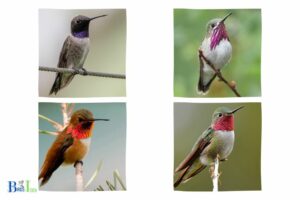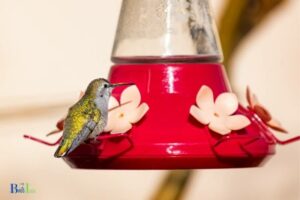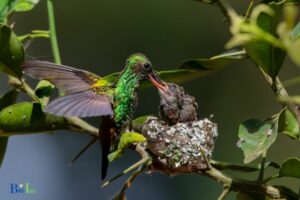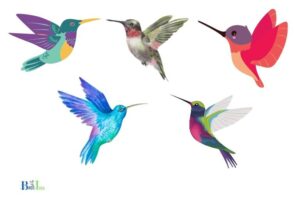What Is A Hummingbird Moth? Facts, Characteristics and Behavior
A hummingbird moth is a type of hawk moth, with species belonging to the family Sphingidae. Hummingbird moths are distinguished from other hawk moths by their hovering and darting flight patterns and their long, slender bodies.
These agile little moths get their common name from their resemblance to hummingbirds in terms of size, appearance and behavior.
- Hummingbird moths belong to the family Sphingidae
- They are distinguished from other hawk moths by their hovering and darting flight patterns
- They resemble hummingbirds in terms of size, appearance and behavior
- They feed on nectar, flowers and other pollinating plants

Hummingbird moths are important pollinators, similar to bees and other insects. They have long tongues that allow them to feed on nectar and other flowers, consequently aiding in the spread of pollen around the garden.
These moths are often mistaken for small hummingbirds due to their unique behavior and appearance.
Insect: What is a Hummingbird Moth?
A hummingbird moth is a small insect that is part of the sphinx moth family. It takes its name from its resemblance to a hummingbird as it hovers near flowers and rapidly flaps its wings. Other features that set it apart from other moths are:
- Its coloration varies from species to species, but typically its wings are uniquely colored and patterned
- It has a long proboscis which it uses to feed on flowers
- It typically has a large body with four wings
- Its size is relatively small – 3-4cm at its largest
- It moves quickly and is able to hover in one place by flapping its wings at an amazing speed.
As well as being an attractive insect, hummingbird moths are also significant pollinators, making them beneficial to the environment. They feed on nectar from a variety of flowers and help spread pollen from one flower to the next – creating vital links between plants.
10 Facts about Hummingbird Moth

- Hummingbird moths are members of the family Sphingidae, which includes over 1,400 species of moths.
- They are also known as hawk moths or sphinx moths.
- Hummingbird moths are named for their resemblance to hummingbirds, as they have long, narrow wings and a slender body.
- They are active during the day and are often seen feeding on flowers.
- These moths are found throughout much of the world, including North and South America, Europe, and Asia.
- Like hummingbirds, hummingbird moths are able to hover in place while feeding on nectar from flowers.
- They have a long proboscis (a tube-like structure used for feeding) that allows them to reach nectar in deep flowers.
- Hummingbird moths are important pollinators and play a vital role in the reproduction of many plant species.
- These moths are generally not attracted to light and are more likely to be found during the day, near flowers.
- Hummingbird moths are relatively small, with most species measuring about 1-3 inches in length.
Hummingbird Moth Characteristics
- Long, narrow wings: Hummingbird moths have wings that are longer and narrower than those of most other moths. This helps them fly quickly and maneuver easily while feeding on nectar from flowers.
- Slender body: Hummingbird moths have a slender, elongated body shape, similar to that of a hummingbird.
- Daytime activity: These moths are active during the day and are often seen feeding on flowers in the early morning and late afternoon.
- Rapid wing beat: Hummingbird moths are able to hover in place while feeding, much like hummingbirds, thanks to their rapid wing beat.
- Long proboscis: These moths have a long, flexible proboscis (a tube-like structure used for feeding) that allows them to reach nectar in deep flowers.
- Pollinators: Hummingbird moths are important pollinators and play a vital role in the reproduction of many plant species.
- Bright colors: Some species of hummingbird moths have brightly colored wings, which may help them attract mates or deter predators.
- Small size: Hummingbird moths are relatively small, with most species measuring about 1-3 inches in length.
- Worldwide distribution: These moths are found throughout much of the world, including North and South America, Europe, and Asia.
- Few predators: Hummingbird moths have few natural predators due to their rapid flight and ability to hover in place.
Hummingbird Moth Behavior

Feeding: Hummingbird moths feed on nectar from flowers using their long proboscis (a tube-like structure used for feeding). They are able to hover in place while feeding, much like hummingbirds.
Pollination: These moths are important pollinators and play a vital role in the reproduction of many plant species. As they feed on nectar, they pick up and deposit pollen from one flower to another, helping to fertilize the flowers and produce seeds.
Mating: Hummingbird moths typically mate during the daytime, with males patrolling areas near flowers in search of females.
Nesting: Some species of hummingbird moths construct nests using silk, while others lay their eggs on leaves or in the ground.
Migration: Some species of hummingbird moths migrate to avoid cold weather or to find food.
Defense mechanisms: Hummingbird moths may use their rapid flight and ability to hover in place as a defense mechanism against predators. Some species also have brightly colored wings, which may help deter predators.
Interactions with humans: Hummingbird moths are generally not aggressive and do not pose a threat to humans. They may be attracted to gardens or other areas with a plentiful supply of nectar-rich flowers.
What Does a Hummingbird Moth Look Like?
Hummingbird moths are small, delicate-looking insects of the family Sphingidae. They have a slender body and narrow wings, and are usually gray or pale yellow in color.
They have long antennae, long legs, and long proboscis (mouthparts). A noticeable feature of the hummingbird moth is the ability to hover in mid-air while feeding, just like a hummingbird. The wings are transparent, with dark veins and a bright pattern near the base.
The hindwings are long and narrow, and the wings effectively allow the moth to move with great agility and nimbleness. Most hummingbird moths have a wingspan of 1-2 inches (2.5-5 cm).
Pollination contributed to 1/3 of global food production, with hummingbird moths playing an important role in this process.
Where Are Hummingbird Moths Found?

Hummingbird moths are found across areas of North America, Europe, and Asia. They can be identified by their slim build and wingspans of up to four inches. They usually inhabit fields, gardens, meadows, parks, and other parts of open spaces.
Hummingbird moths are known for their unique eating habits, hovering over flowers to feed on nectar and pollen, much like hummingbirds. Some are even able to remain airborne while they feed.
Here are some of the areas in which hummingbird moth can be found:
- Eastern North American
- Western North America
- Central North American
- Northeastern Europe
- Northwestern Europe
- Eastern Europe
- China
- Japan
- India
Hummingbird moths inhabit areas with plenty of wildflowers and a mild climate, where they can feed and live comfortably. They prefer moist climates, since these provide more abundant flowers.
What Do Hummingbird Moths Eat?

Hummingbird moths feed primarily on nectar and pollen from flowers. This makes them beneficial pollinators and helps to keep plant populations healthy.
Other foods that hummingbird moths may consume include the juices of ripe fruit, honeydew from sap-sucking insects and occasionally, even small insects.
Benefits of hummingbird moths:
- Help balance ecosystem by pollinating flowers
- Provide nectar for other pollinating insects
- Produce beneficial enzymes and bacteria for soil health
- Prevent the overabundance of certain plants
- Reduce the spread of tree-destroying pests
- Help increase crop production and growth
- Consume the flowers of invasive species
- Aesthetic value and entertainment
- Pollinate plants even in low temperatures
Hummingbird moths are highly valuable in their natural landscapes, helping to balance ecosystems and provide food for other pollinators.
They have a wide variety of benefits for soil health, crop production, and can even help to prevent the spread of tree-destroying pests. Additionally, the aesthetic value that they provide can bring joy and entertainment to viewers.
How Do Hummingbird Moths Reproduce?
Hummingbird moths reproduce by laying eggs near host plants. The eggs are small and hard to detect. They often deposit them on the underside of leaves.
Once hatched, the larvae feed on the leaves of host plants. When mature, the larvae typically find a protected location such as leaf litter or bark crevices to pupate before emerging as adult moths.
What Are the Benefits of Having Hummingbird Moth?

Hummingbird moths are beneficial garden visitors, as they help to pollinate flowers. These moths can be particularly useful in controlling pests, as their long tongues help them to reach nectar deep in the centers of hard-to-reach flowers.
Some plants such as trumpet honeysuckle, bee balm and salvia are highly attractive to hummingbird moths.
Benefits of having hummingbird moths include:
- Providing pollination: The long tongues of hummingbird moths help them to reach deep into flower centers, allowing them to effectively pollinate blooms.
- Controlling pests: Hummingbird moths can help discourage pests by feeding on nectar.
- Attracting other creatures: By providing a food source for hummingbird moths, other pollinators such as butterflies and bees may also be attracted.
- Helping with conservation: Hummingbird moths are a natural resource and by providing suitable habitats, gardeners can help create refuges for the moths.
- Enhancing gardens: Gardening with hummingbird moths in mind can contribute to a more dynamic design and contribute to increasing biodiversity.
- Increasing curbside appeal: By having friendly and attractive hummingbird moths present in a garden, it can help improve the look of the landscape and attract more visitors.
- Providing entertainment: Watching the unique and graceful movements of these moths can provide hours
How Do Hummingbird Moths Defend Themselves?
Hummingbird moths have many defensive adaptations to protect themselves from predators. These include camouflage, defensive behaviors, toxic chemicals, and physical defense.
Camouflage allows the moths to blend into their environment, while defensive behaviors such as swiftly flying away or standing immobile can confuse or startle potential predators.
Hummingbird moths produce noxious chemicals that deter predators, as well as venom that is released when the moth is attacked.
Along with camo and defensive behaviors, some species of hummingbird moths have long spines on their wings, which can fork and pierce would-be predators.
FAQ
What is a hummingbird moth?
What makes hummingbird moths distinct?
Do hummingbird moths pollinate?
What is the lifespan of a hummingbird moth?
Conclusion:
Hummingbird moths are important pollinators and can be mistaken for small birds due to their unique characteristics. These moths belong to the Sphingidae family and can be distinguished from other hawk moths by their hovering and darting flight patterns, size and appearance.






